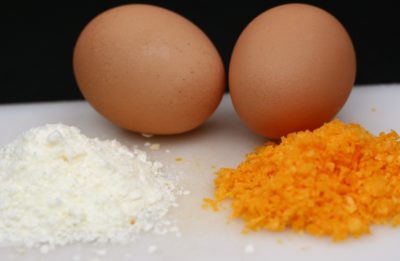
Images source: ourhikingblog.com
Dehydrating what you grow or find on sale at the local grocery store is a great way to add to long term food storage stockpiles and feed a family healthy food on a budget. Fresh vegetables and fruit plucked right from the garden or grove are items commonly dehydrated, but a plethora of dairy products can successfully be dehydrated as well.
When dehydrating dairy items, the trays of the dehydrator will need what are commonly referred to as “fruit rollup trays.” The clear plastic liners prevent more liquid type food from slipping through the vents in the tray. I also use these trays when dehydrating corn and lettuce, since they tend to shrivel up into tiny pieces. Some folks suggest using cling wrap on the trays to avoid buying the plastic inserts. This works for the most part with many types of foods, but is extremely messy and difficult to keep in place. Since the inserts are only a few dollars each and are simplistic to use – splurge and buy the trays.
Here are four food items you may not have known could be dehydrated:
1. Eggs
Lucky farmers, whether they are of the small backyard variety or responsible for a spacious spread, often wind up with too many chicken or duck eggs to consume before they go bad. Selling the eggs is of course one option for the leftover eggs, but so is dehydrating. I won’t have my own chickens until we finally get moved onto our dream land in a few months, but when cartons go on special at the store for $.99, I stock up and remove my trusty dehydrator from the cabinet.
- Pour one dozen chicken eggs in a blender or food processor. Duck eggs are larger, so perhaps use just 10 of these in each batch.
- Pulsate the eggs until they are thoroughly blended together. Choose whichever setting works best for you, or go the old-fashioned route and stir in a bowl until thoroughly mixed.
- Place a fruit tray insert (or wrap the tray with cling wrap) into dehydrator trays. Pour the mixture until it fills about half the depth of the tray. Thicker mixtures do not dry evenly and take longer to complete.
- Pour half of the egg mixture onto a tray. Each tray will hold approximately six eggs. Use up to four trays and two dozen eggs at a time.
- Set the dehydrator to the fruit and vegetable setting, or 135 degrees.
- Dehydrate eggs for seven to nine hours, depending upon the size and power of your dehydrator.
- The eggs will look and feel a bit like peanut brittle when done. Pat away any greasy texture on top of the eggs.
- You can store the eggs in their flat form in either a Mason jar or vacuum sealed bag or powder the eggs in a blender to conserve storage space. Putting the flat dehydrated eggs into a small bowl and “crunching” with a wooden spoon will also result in a powdered texture.
- To rehydrate the eggs, mix one tablespoon of powder with two tablespoons of lukewarm to warm water. Let stand five minutes and use to bake, scramble or cook with as you would fresh eggs. Personally, I find it difficult to taste the difference between dehydrated and store-bought eggs when using them to scramble in the morning or in a recipe. When stored properly, many feel that the eggs remain shelf stable for a minimum of five and a maximum of 10 years.
2. Sour Cream
Commercially dehydrated sour cream is extremely difficult to find, and when available, sticker shock usually occurs. Dehydrating sour cream is yet another way to make good use of excessive farm offerings.
Are You Ready For The Coming Food Riots?
A typical cow produces just over six gallons of milk per day. Unless selling or herd-sharing the raw milk, there is likely plenty of milk left over to make sour cream, cottage cheese, ice cream, yogurt and cheese.
- Spread a thin layer of sour cream onto a fruit tray insert and place it into the dehydrator tray. Do not fill the tray more than halfway full. Filling the sour cream to about a quarter of the depth of the tray is recommended for even drying.
- Set the dehydrator to 135 degrees and allow to dry for about 10 hours. If you own a very strong dehydrator, adjust the setting down five degrees to avoid any “browning” or singing of the sour cream.
- When thoroughly dried, the sour cream will look a bit like thin white chocolate. Turn the insert tray upside down and bend backwards the exterior lip of the tray slightly and gently to allow the dehydrated sour cream to fall onto a clean surface. If the sour cream refuses to budge, place the unwrapped tray into the freezer for about 15 minutes and repeat the process.
- The dehydrated sour cream can be stored in a Mason jar or vacuum sealed bag in a cool dark place for approximately five years. You can also powder the sour cream in the same manner as the eggs to conserve storage space.
- To rehydrate the dehydrated sour cream, mix as with the eggs, but use only lukewarm water to prevent any curdling.
3. Cottage Cheese
Follow the sour cream steps to dehydrate, rehydrate and store cottage cheese. Thinly spreading the mixture is the key to success with this food item. A slightly yellow tinge to the mixture will likely result during the drying process.
4. Lettuce
Preserving lettuce does not have to be a difficult task. Canning or freezing lettuce is virtually impossible, but dehydrating is a breeze. We have three rescued Sulcata tortoises and four birds, all of which should have a lot of green leafy vegetables in their diet.
We grow an abundance of lettuce to feed our pets during the winter months, a huge cost saver. Duke, the largest Sulcata, weighs 60 pounds (they will reach 100 pounds at full maturity) and eats a lot fresh veggies on a daily basis. By dehydrating lettuce we grow and find on sale, our winter food budget is cut significantly.
- Tear off pieces of lettuce that are approximately three inches longer, or longer after the head has been washed.
- Place the lettuce onto fruit liners and place in the tray. Quicker and more even drying occurs when the lettuce strips do not touch.
- Set the dehydrator on 130 to 135 degrees and dry for approximately four hours.
- Use a butter knife or similar kitchen tool to pry the lettuce from the tray if stuck a bit and place in a Mason jar or vacuum sealed bag for storage. The lettuce should last for at least five years.
- To rehydrate, spritz the lettuce with cold to lukewarm water until it regains its natural form. Lightly spritz and wait five minutes to see any signs of change before rehydrating. If giving the lettuce to animals, it does not necessarily need to be rehydrated, especially if it will be mixed with other dehydrated or fresh fruits and vegetables.
Sign up for Off The Grid News’ weekly email and stay informed about the issues important to you
 Off The Grid News Better Ideas For Off The Grid Living
Off The Grid News Better Ideas For Off The Grid Living




